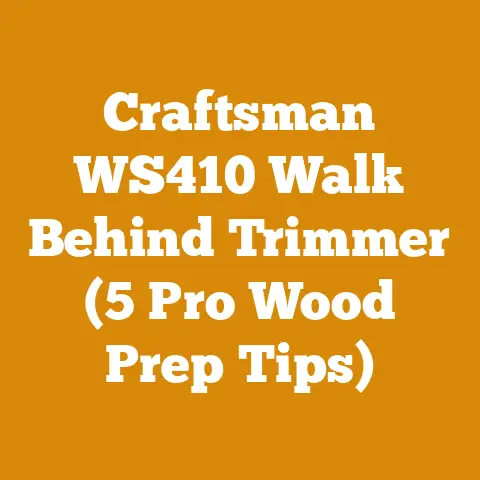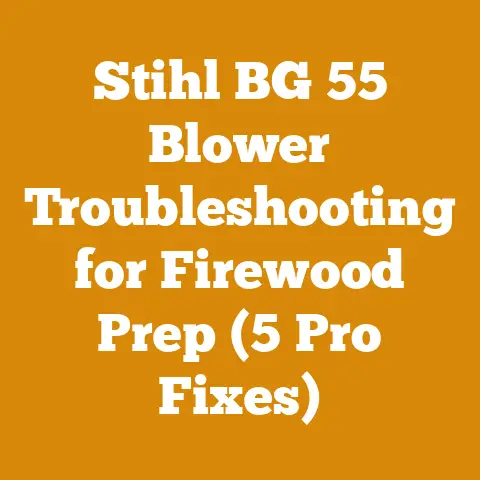Primer Bulb Not Filling Fixes (5 Pro Tips for Chainsaw Users)
Ever yanked on your chainsaw’s starter cord, only to be met with frustrating silence? The culprit might be that little primer bulb, stubbornly refusing to fill with fuel. What if I told you that a simple fix could be all you need to get your saw roaring back to life?
I’ve spent years in the woods, wrestling with chainsaws, felling trees, and prepping firewood. I’ve seen firsthand how a seemingly minor issue like a faulty primer bulb can bring a whole operation to a screeching halt. Let me share my hard-earned wisdom to help you diagnose and fix this common problem, saving you time, money, and a whole lot of frustration.
Primer Bulb Not Filling: 5 Pro Tips for Chainsaw Users
The primer bulb on your chainsaw is a small but crucial component. It’s designed to draw fuel from the tank to the carburetor, making starting easier, especially in cold weather. When it fails to fill, your chainsaw will likely refuse to start. In this guide, I’ll walk you through five pro tips to troubleshoot and fix this issue, drawing from my own experiences in the field.
Understanding the Primer Bulb System
Before diving into the fixes, let’s understand how the primer bulb system works. The bulb is connected to the fuel tank and carburetor through a series of fuel lines. When you press the bulb, it creates a vacuum, drawing fuel from the tank and pushing it towards the carburetor. This primes the engine, ensuring it has enough fuel to start.
A typical chainsaw fuel system includes:
- Fuel Tank: Holds the fuel mixture (gas and oil).
- Fuel Filter: Located inside the tank, it prevents debris from entering the fuel lines.
- Fuel Lines: Connect the tank to the primer bulb and carburetor.
- Primer Bulb: Creates suction to draw fuel.
- Carburetor: Mixes fuel and air for combustion.
Understanding this system is the first step to diagnosing the problem.
Tip 1: Inspect and Clean the Fuel Filter
A clogged fuel filter is one of the most common reasons why a primer bulb won’t fill. Over time, debris and contaminants can accumulate in the fuel tank, clogging the filter and restricting fuel flow.
My Experience: I once spent a whole morning troubleshooting a chainsaw that wouldn’t start. After checking everything else, I finally pulled the fuel filter and found it completely encased in gunk. A quick cleaning, and the saw fired right up.
How to Inspect and Clean:
- Locate the Fuel Filter: It’s usually inside the fuel tank, attached to the end of a fuel line.
- Remove the Filter: Use a piece of wire or a hooked tool to pull the fuel line and filter out of the tank. Be careful not to damage the fuel line.
- Inspect the Filter: Check for any visible signs of dirt, debris, or clogs.
- Clean the Filter:
- Option 1 (Cleaning): Submerge the filter in fresh fuel or carburetor cleaner and gently scrub it with a small brush. You can also use compressed air to blow out the debris.
- Option 2 (Replacement): If the filter is severely clogged or damaged, replace it with a new one. Fuel filters are inexpensive and readily available at most hardware stores or online.
- Reinstall the Filter: Reattach the filter to the fuel line and carefully insert it back into the fuel tank.
Tools Needed:
- Small wire or hooked tool
- Fresh fuel or carburetor cleaner
- Small brush
- Compressed air (optional)
- New fuel filter (if needed)
Metrics: Aim to clean or replace your fuel filter at least once a year, or more frequently if you use your chainsaw heavily or notice fuel flow issues.
Takeaway: A clean fuel filter ensures a steady supply of fuel, which is crucial for proper primer bulb function.
Tip 2: Check and Replace Damaged Fuel Lines
Fuel lines are another common culprit behind a non-filling primer bulb. Over time, these lines can crack, harden, or become disconnected, leading to air leaks that prevent the bulb from creating the necessary vacuum.
My Experience: I once had a chainsaw that would start but quickly die. The primer bulb seemed to work, but the engine wasn’t getting enough fuel. After a thorough inspection, I found a tiny crack in one of the fuel lines, allowing air to enter the system. Replacing the line solved the problem instantly.
How to Check and Replace Fuel Lines:
- Inspect the Fuel Lines: Carefully examine all fuel lines for cracks, kinks, or disconnections. Pay close attention to the areas where the lines connect to the fuel tank, primer bulb, and carburetor.
- Test for Leaks: With the fuel tank full, gently squeeze the fuel lines to check for leaks. You can also use a spray bottle filled with soapy water to check for air bubbles.
- Replace Damaged Lines: If you find any damaged fuel lines, replace them with new ones of the correct size and type.
- Measure the Old Line: Before removing the old line, measure its length and diameter to ensure you get the correct replacement.
- Cut the New Line: Cut the new fuel line to the appropriate length using a sharp utility knife or fuel line cutter.
- Install the New Line: Carefully attach the new fuel line to the fuel tank, primer bulb, and carburetor. Make sure the connections are secure and airtight.
Tools Needed:
- Utility knife or fuel line cutter
- Screwdrivers (for removing clamps, if necessary)
- New fuel lines (of the correct size and type)
- Spray bottle with soapy water (optional)
Measurements: Fuel line diameters typically range from 1/8 inch to 3/16 inch. Ensure you use the correct size for your chainsaw model.
Takeaway: Fuel lines are relatively inexpensive and easy to replace. Regularly inspecting and replacing them can prevent a host of fuel-related issues.
Tip 3: Examine the Primer Bulb Itself
The primer bulb itself can also be the source of the problem. Over time, the rubber can deteriorate, crack, or become stiff, preventing it from creating a proper seal and drawing fuel.
My Experience: I’ve seen primer bulbs that were so brittle they crumbled to the touch. In other cases, the bulb was intact but had lost its elasticity, making it impossible to create suction.
How to Examine the Primer Bulb:
- Visual Inspection: Check the primer bulb for cracks, tears, or signs of deterioration.
- Test for Elasticity: Press the bulb and see if it returns to its original shape quickly. A stiff or unresponsive bulb needs replacement.
- Check for Leaks: With the fuel tank full, press the bulb and check for fuel leaks around its base.
How to Replace the Primer Bulb:
- Remove the Old Bulb: Depending on the chainsaw model, the primer bulb might be held in place by a retaining ring or simply pressed into a hole in the carburetor housing. Gently pry it out using a small screwdriver or pick.
- Install the New Bulb: Align the new bulb with the hole and press it firmly into place until it’s fully seated.
Tools Needed:
- Small screwdriver or pick
- New primer bulb (of the correct size and type)
Metrics: Primer bulbs typically cost between $5 and $15. Consider replacing the bulb every 2-3 years, or sooner if you notice any signs of wear or damage.
Takeaway: A functional primer bulb is essential for starting your chainsaw. Don’t overlook this simple component when troubleshooting fuel-related issues.
Tip 4: Clear Obstructions in the Carburetor
While the primer bulb primarily draws fuel, issues within the carburetor can also prevent it from filling properly. A clogged or malfunctioning carburetor can create backpressure, making it difficult for the bulb to draw fuel.
My Experience: I once worked on a chainsaw that had been sitting idle for a long time. The primer bulb wouldn’t fill, and I suspected a carburetor issue. After disassembling the carburetor and cleaning out the jets, the primer bulb started working perfectly.
How to Clear Obstructions in the Carburetor:
- Check the Carburetor Jets: The carburetor jets are small openings that regulate fuel flow. They can easily become clogged with varnish or debris, especially if the chainsaw has been sitting unused for an extended period.
- Clean the Jets:
- Disassemble the Carburetor: Carefully disassemble the carburetor, taking note of the location of each component.
- Clean the Jets: Use carburetor cleaner and a small wire or carburetor jet cleaning tool to clear any obstructions in the jets.
- Reassemble the Carburetor: Reassemble the carburetor, making sure all components are properly aligned and tightened.
- Adjust the Carburetor Settings: After cleaning the carburetor, you might need to adjust the idle speed and fuel mixture settings to ensure proper engine performance.
Tools Needed:
- Screwdrivers (for disassembling the carburetor)
- Carburetor cleaner
- Small wire or carburetor jet cleaning tool
- Compressed air (optional)
Measurements: Carburetor adjustments are typically measured in turns of the adjustment screws. Consult your chainsaw’s owner’s manual for the recommended settings.
Takeaway: A clean and properly adjusted carburetor is essential for optimal engine performance and proper primer bulb function.
Tip 5: Ensure Proper Venting of the Fuel Tank
The fuel tank needs to be properly vented to allow air to enter as fuel is drawn out. If the vent is blocked, a vacuum can form in the tank, preventing the primer bulb from drawing fuel.
My Experience: I once encountered a chainsaw that would run for a few minutes and then die. The primer bulb would become difficult to press, and I suspected a fuel tank venting issue. After cleaning the vent, the problem disappeared.
How to Ensure Proper Venting:
- Locate the Fuel Tank Vent: The vent is usually a small hole or valve located on the fuel tank cap or near the fuel lines.
- Check for Obstructions: Inspect the vent for any dirt, debris, or blockages.
- Clean the Vent: Use a small wire or compressed air to clear any obstructions.
- Test the Vent: With the fuel tank cap loose, try pressing the primer bulb. If it fills easily, the vent is likely working properly. If it’s still difficult to press, the vent might be faulty and need replacement.
Tools Needed:
- Small wire
- Compressed air (optional)
Metrics: Fuel tank vents are relatively inexpensive and easy to replace. Consider replacing the vent every few years, or sooner if you suspect it’s not working properly.
Takeaway: Proper fuel tank venting is crucial for maintaining consistent fuel flow and preventing primer bulb issues.
Beyond the Basics: Advanced Troubleshooting
If you’ve tried all the above tips and your primer bulb still isn’t filling, the problem might be more complex. Here are a few additional troubleshooting steps to consider:
- Check the Impulse Line: The impulse line connects the carburetor to the engine crankcase. It transmits pressure pulses that help draw fuel from the tank. A cracked or disconnected impulse line can prevent the primer bulb from working properly.
- Inspect the Carburetor Diaphragm: The carburetor diaphragm regulates fuel flow based on engine vacuum. A damaged or stiff diaphragm can prevent the carburetor from drawing fuel, affecting the primer bulb.
- Consider Professional Help: If you’re not comfortable disassembling and repairing the carburetor or other engine components, it’s best to take your chainsaw to a qualified repair technician.
Preventative Maintenance: Keeping Your Chainsaw in Top Shape
Preventative maintenance is key to avoiding primer bulb and other chainsaw issues. Here are a few tips to keep your chainsaw in top shape:
- Use Fresh Fuel: Always use fresh fuel mixed with the correct ratio of oil. Old fuel can break down and clog the fuel system.
- Store Your Chainsaw Properly: When storing your chainsaw for extended periods, drain the fuel tank and run the engine until it stalls to prevent fuel from gumming up the carburetor.
- Clean Your Chainsaw Regularly: Clean your chainsaw after each use to remove sawdust, debris, and oil buildup.
- Sharpen the Chain: A sharp chain reduces the strain on the engine and fuel system.
Conclusion: A Proactive Approach to Chainsaw Maintenance
A primer bulb that won’t fill can be a frustrating problem, but with a systematic approach, you can usually diagnose and fix the issue yourself. By inspecting and cleaning the fuel filter, checking and replacing damaged fuel lines, examining the primer bulb itself, clearing obstructions in the carburetor, and ensuring proper venting of the fuel tank, you can keep your chainsaw running smoothly and efficiently. Remember, preventative maintenance is key to avoiding problems and extending the life of your chainsaw.






